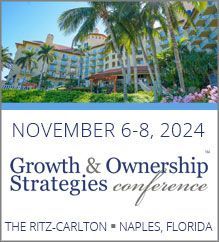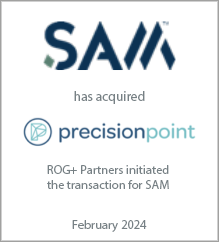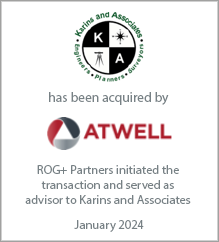Carl specializes in corporate financial advisory services including strategic business planning, financing strategies, operational effectiveness, ownership transition, business valuations, mergers and acquisitions, stock structuring, corporate governance and profit enhancement. He leads ROG’s West Coast office and brings the unique perspective of a past business owner to ROG’s team.
Are You Tracking The Right Metrics For Your Firm?
Are You Tracking The Right Metrics For Your Firm?
September 6, 2019
I stopped counting at about 200. That was the number of metrics I found in various publications that track financial results for the design profession. Though the sheer number was overwhelming, they all seemed perfectly good and most of them understandable. So, if they are all useful, which ones are the right ones for your firm? The simple answer is – the ones that drive action toward the results you want. Said another way, the metrics you use should show you what action you need to take to reach your goals.
Let’s begin by saying that metrics are a powerful tool for running your business. Combined with timely and accurate financial statements, they are key to driving the value of your firm. If you are not using metrics, I encourage you to start. If you are using metrics, great; now it’s time to re-think the ones you are using.
As a design professional, you are probably very familiar with the usual (dare I say mundane) utilization rate, direct labor rate, overhead rate, net multiplier, etc. Those are the industry favorites, and you might be tracking those right now. I challenge you to ask yourself if those are driving action in your firm. If they are not and are merely nice to know, then you should start taking action on them or ditch them in favor of some that will create action.
Here are my suggestions for deciding which metrics are right for your firm. First, limit the number to no more than 10. Any more than that is unnecessary. Keep things simple. Next, pick 5 or 6 that are based on getting the work, doing the work, and getting paid for the work. To that end, I would suggest the following metrics as a foundation:
Get the Work
New Contracted Work (in $’s) – it’s important to know if and to what extent your marketing, sales, and business development programs are working.
Proposals Let (in $’s) – this will let you know if you are too busy doing the work to find new work. You need to know the dollar volume of proposals that have been sent out.
Do the Work
Revenue Factor – this is net revenue divided by total wages. This is the king of all metrics. If you were only to use one metric, this would be it. It tells you how effectively you are using your labor cost to produce revenue. Make sure you use revenue factor on actual revenue AND forecasted revenue. Using forecasted revenue will let you know if you need to increase or decrease staff cost. Also, if you choose to use utilization rate as a metric (and I’m not able to talk you out of it), you will want to use revenue factor to get a more complete picture of labor efficiency.
Direct Labor Percentage – direct labor divided by net revenue. This is another labor efficiency measure but at the project level. If your rate is too high, it could be that you have inefficiencies in producing the work, or you have the wrong cost mix of labor on the projects. It could be that your fees are too low. In any case, monitoring this metric will create action.
Pre-bonus, Pre-tax Profit (as a % of net revenue) – seems obvious, but you’d be surprised in how few financial statements or metrics presentations this percentage appears.
Get Paid for the Work
Percentage of Total Accounts Receivable under 91 Days (in $’s) – or it could be 75 days or any other amount that works for you. I prefer this to Average Collection Period (ACP) or Days Sales Outstanding (DSO) which are expressed in number of days. I think it is more impactful to see money than days, and it’s a lot easier to calculate and explain than ACP or DSO.
Now that you’ve picked 5 or 6 from among the categories above, it is time to bring the total metrics to 10. You do this by adding 4 or 5 metrics that are specific to driving your strategic plan, eliminating a problem or simply putting focus on areas of your business that need specific attention. Let’s say that one of your strategic goals for this year is to diversify your client type and, in particular, you want more government work. You could use a metric that measures the amount of new contracted work in government. Or you could track the percentage of government revenue or sales to total revenue or sales. If you are having trouble with your employee retention rate, how about a metric that tracks employee attrition? If you have debt covenants, how about a metric that tracks those covenants? Let’s say you have an initiative to diversify your client base. You could use a metric that tracks the revenue from new clients.
There is an endless number of metrics that you could use, but the main points to keep in mind when choosing the ones to use and when implementing their uses are:
The right metrics can be a powerful tool in achieving operating excellence. If you are not using metrics and would like help in getting started, or if you are already using metrics but maybe not as effectively as you would like, please give us a call.
See Carl and learn more at:
September 18, 2019
Arizona Grand Resort, Phoenix, AZ
Successful Ownership Transition Strategies: One Day Seminar
Click here for more details and to register.
Or listen in on this Webinar:
October 24, 2019 at 2:00pm ET
3 Ways to Drive Value Within Your A&E Firm
Presented by Deltek and ROG+ Partners
Click here for more details and to register.
Wednesday, November 6 – Friday, November 8, 2019
Ritz-Carlton Golf Resort, Naples, FL
Growth & Ownership Strategies Conference
Click here for more details and to register.
Let’s begin by saying that metrics are a powerful tool for running your business. Combined with timely and accurate financial statements, they are key to driving the value of your firm. If you are not using metrics, I encourage you to start. If you are using metrics, great; now it’s time to re-think the ones you are using.
As a design professional, you are probably very familiar with the usual (dare I say mundane) utilization rate, direct labor rate, overhead rate, net multiplier, etc. Those are the industry favorites, and you might be tracking those right now. I challenge you to ask yourself if those are driving action in your firm. If they are not and are merely nice to know, then you should start taking action on them or ditch them in favor of some that will create action.
Here are my suggestions for deciding which metrics are right for your firm. First, limit the number to no more than 10. Any more than that is unnecessary. Keep things simple. Next, pick 5 or 6 that are based on getting the work, doing the work, and getting paid for the work. To that end, I would suggest the following metrics as a foundation:
Get the Work
New Contracted Work (in $’s) – it’s important to know if and to what extent your marketing, sales, and business development programs are working.
Proposals Let (in $’s) – this will let you know if you are too busy doing the work to find new work. You need to know the dollar volume of proposals that have been sent out.
Do the Work
Revenue Factor – this is net revenue divided by total wages. This is the king of all metrics. If you were only to use one metric, this would be it. It tells you how effectively you are using your labor cost to produce revenue. Make sure you use revenue factor on actual revenue AND forecasted revenue. Using forecasted revenue will let you know if you need to increase or decrease staff cost. Also, if you choose to use utilization rate as a metric (and I’m not able to talk you out of it), you will want to use revenue factor to get a more complete picture of labor efficiency.
Direct Labor Percentage – direct labor divided by net revenue. This is another labor efficiency measure but at the project level. If your rate is too high, it could be that you have inefficiencies in producing the work, or you have the wrong cost mix of labor on the projects. It could be that your fees are too low. In any case, monitoring this metric will create action.
Pre-bonus, Pre-tax Profit (as a % of net revenue) – seems obvious, but you’d be surprised in how few financial statements or metrics presentations this percentage appears.
Get Paid for the Work
Percentage of Total Accounts Receivable under 91 Days (in $’s) – or it could be 75 days or any other amount that works for you. I prefer this to Average Collection Period (ACP) or Days Sales Outstanding (DSO) which are expressed in number of days. I think it is more impactful to see money than days, and it’s a lot easier to calculate and explain than ACP or DSO.
Now that you’ve picked 5 or 6 from among the categories above, it is time to bring the total metrics to 10. You do this by adding 4 or 5 metrics that are specific to driving your strategic plan, eliminating a problem or simply putting focus on areas of your business that need specific attention. Let’s say that one of your strategic goals for this year is to diversify your client type and, in particular, you want more government work. You could use a metric that measures the amount of new contracted work in government. Or you could track the percentage of government revenue or sales to total revenue or sales. If you are having trouble with your employee retention rate, how about a metric that tracks employee attrition? If you have debt covenants, how about a metric that tracks those covenants? Let’s say you have an initiative to diversify your client base. You could use a metric that tracks the revenue from new clients.
There is an endless number of metrics that you could use, but the main points to keep in mind when choosing the ones to use and when implementing their uses are:
- Start with a few from the basic groups of get the work, do the work, and get paid for the work
- Keep the number of metrics you use to no more than 10
- Make sure they are simple and understandable
- Track them against specific targets
- Make sure they create action and accountability
- Report on them monthly and year to date (or better yet, latest 12 months)
- Follow up on corrective action items
The right metrics can be a powerful tool in achieving operating excellence. If you are not using metrics and would like help in getting started, or if you are already using metrics but maybe not as effectively as you would like, please give us a call.
See Carl and learn more at:
September 18, 2019
Arizona Grand Resort, Phoenix, AZ
Successful Ownership Transition Strategies: One Day Seminar
Click here for more details and to register.
Or listen in on this Webinar:
October 24, 2019 at 2:00pm ET
3 Ways to Drive Value Within Your A&E Firm
Presented by Deltek and ROG+ Partners
Click here for more details and to register.
Wednesday, November 6 – Friday, November 8, 2019
Ritz-Carlton Golf Resort, Naples, FL
Growth & Ownership Strategies Conference
Click here for more details and to register.
Latest Perspective
Perfecting the A/E Exit Strategy – Five Key Factors
An enormous A/E generation that kicked off their careers in the 1980s and subsequently started firms or became owners in the 1990s ...
© 2024
Rusk O'Brien Gido + Partners, LLC
Financial Experts for Architects, Engineers, and Environmental Consulting Firms









